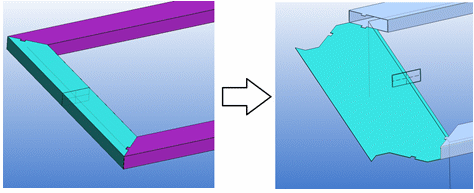Convert a Part or Profile to a Sheet Metal Part
Sheet-Metal Design
General
You can convert a normal part to a sheet metal part in different ways.
- Change the type of the part to sheet metal (see A).
- Use the function Convert as sheet metal part (see B).
- Import a part modeled in another cad system as a sheet metal part.
You can convert profile parts of an assembly to sheet metal parts (see C).
- The function is useful when the parts are profile-like, but they are made from sheet metal by bending.
- You can, for example, convert profiles edged from sheet metal into a format that enables the easy edging of parts from sheet metal.

(A) Change the type of part model to sheet metal
- Select the context-sensitive function
 Properties in the model window.
Properties in the model window.- The program opens the dialog box Part Properties.
- Select
 Sheet Metal as the type.
Sheet Metal as the type.- The program asks: Is extrusion length used as sheet thickness?
- If the extrusion thickness is suitable for the thickness of the sheet metal, select Yes.
- Select the properties of the sheet metal. Sheet Metal Parameters.
- Exit the Part Properties dialog by clicking OK.
- If the extrusion thickness is not suitable for sheet metal thickness, select No.
- The program asks: Do you want to select a surface (to speedup)?
- If you want to select the surface on which the thickness of the sheet is correct, select Yes.
- Click the face.
- Select the properties of the sheet metal. Sheet Metal Parameters.
- Exit the Part Properties dialog by clicking OK.
- If you do not want to show the surface, select No.
- The program determines the sheet thickness automatically using the largest planar surface and its opposite surface.
- Select the properties of the sheet metal. Sheet Metal Parameters.
- Exit the Part Properties dialog by clicking OK.
B) Convert a part model to a sheet metal part
- In the model window, select the context-sensitive function .
- The program opens the dialog box Sheet Metal Parameters.
- Sheet Metal Parameters
- Enter the parameters of the sheet metal part.
- Select OK.
The program adds rounded radii to sharp corners

(C) Conversion of assembly parts to sheet metal parts
Convert as sheet metal part function performs the following actions:
- Sets
 Sheet Metal as the part's type in the part properties.
Sheet Metal as the part's type in the part properties. - Finds the sheet metal thickness, based on the distance between the part's largest planar face and its opposite surface.
- Creates roundings in the sharp corners if necessary.
- Cuts the sheet metal if the profile in question is closed.
- Creates a tangential shelling for the profile. The same thickness is set for all parts.
Convert assembly parts to sheet metal parts
- Select the context-sensitive function Convert as sheet metal parts... in the model window.
- The program opens the dialog box Convert as Sheet Metal Part.

- The program opens the dialog box Convert as Sheet Metal Part.
- Select the parts that you wish to convert into sheet metal parts.
- By default all parts are selected.
- If you would like to select the cutting faces for closed profiles and the reference face for the tangential offset, select
 Click tangential offset and cutting for profile.
Click tangential offset and cutting for profile.- If you do not select
 Click tangential offset and cutting for profile, the program will perform the conversions automatically.
Click tangential offset and cutting for profile, the program will perform the conversions automatically.
- If you do not select
- Select OK.
- The program opens the dialog box Sheet Metal Parameters.
- Define the parameters of the sheet-metal part.
- Material.
- Thickness.
- Bend radius.
- Stretch calculation.
- Ruled surface tolerance.
- See Parameters of a Sheet-metal Part
- Select OK.
- The program asks for the parameters of the sheet metal for all parts of different thickness (steps 5...6) until every part suitable for sheet metal part has been converted.
